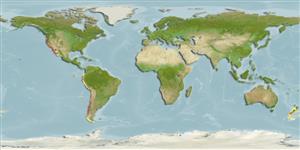Environment: milieu / climate zone / depth range / distribution range
Ecología
marino; salobre demersal; rango de profundidad 0 - 280 m (Ref. 34024). Subtropical; 47°N -
Eastern Pacific: Washington, USA to Baja California and Ecuador. Record from the Gulf of California is doubtful.
Tamaño / Peso / Age
Maturity: Lm ? range ? - ? cm
Max length : 40.4 cm TL macho / no sexado; (Ref. 30541); common length : 30.0 cm TL macho / no sexado; (Ref. 55763)
Short description
Morfología | Morfometría
Espinas dorsales (total): 0; Radios blandos dorsales (total): 187-229; Espinas anales 0; Radios blandos anales: 150 - 181; Vértebra: 86 - 91. Head naked; scales on body in basketweave pattern; precaudal vertebrae 18-19; swim bladder in males with posterior opening; body and head with numerous dark spots and blotches (Ref. 34024). Branchiostegal rays: 7 (Ref. 36413). Pelvic fin consists of one ray with two branches of unequal length (Ref. 36413).
Uncommon species found on sandy bottom from the shore to 280 m (Ref. 34024). Adults often burrow tail-first in sand, live in mucus-lined holes (Ref. 2850), mud, eelgrass and rock rubble (Ref. 36413). Mostly active at night and on overcast days (Ref. 2850). Important food for sea lions and cormorants (Ref. 2850). Oviparous, with planktonic larvae and extended pelagic juvenile (Ref. 36413). Oval, pelagic eggs float in a gelatinous mass (Ref. 205).
Life cycle and mating behavior
Madurez | Reproducción | Puesta | Huevos | Fecundidad | Larva
Nielsen, J.G., D.M. Cohen, D.F. Markle and C.R. Robins, 1999. Ophidiiform fishes of the world (Order Ophidiiformes). An annotated and illustrated catalogue of pearlfishes, cusk-eels, brotulas and other ophidiiform fishes known to date. FAO Fish. Synop. 125(18):178p. Rome: FAO. (Ref. 34024)
IUCN Red List Status (Ref. 130435)
Threat to humans
Harmless
Human uses
Pesquerías: sin interés
Más información
Age/SizeCrecimientoLength-weightLength-lengthLength-frequenciesMorfometríaMorfologíaLarvaDinámica larvariaReclutamientoAbundanciaBRUVS
ReferenciasAcuiculturaPerfil de acuiculturaRazasGenéticaElectrophoresesheritabilidadEnfermedadesProcesamientoNutrientsMass conversion
Herramientas
Special reports
Download XML
Fuentes de Internet
Estimates based on models
Preferred temperature (Ref.
123201): 9.3 - 15.1, mean 11.3 °C (based on 51 cells).
Phylogenetic diversity index (Ref.
82804): PD
50 = 1.0000 [Uniqueness, from 0.5 = low to 2.0 = high].
Bayesian length-weight: a=0.00102 (0.00046 - 0.00225), b=3.06 (2.88 - 3.24), in cm total length, based on all LWR estimates for this body shape (Ref.
93245).
Nivel trófico (Ref.
69278): 4.1 ±0.57 se; based on food items.
Generation time: 2.9 ( na - na) years. Estimated as median ln(3)/K based on 1
growth studies.
Resiliencia (Ref.
120179): Medio, población duplicada en un tiempo mínimo de 1.4-4.4 años (K=0.3).
Fishing Vulnerability (Ref.
59153): Low to moderate vulnerability (32 of 100).
